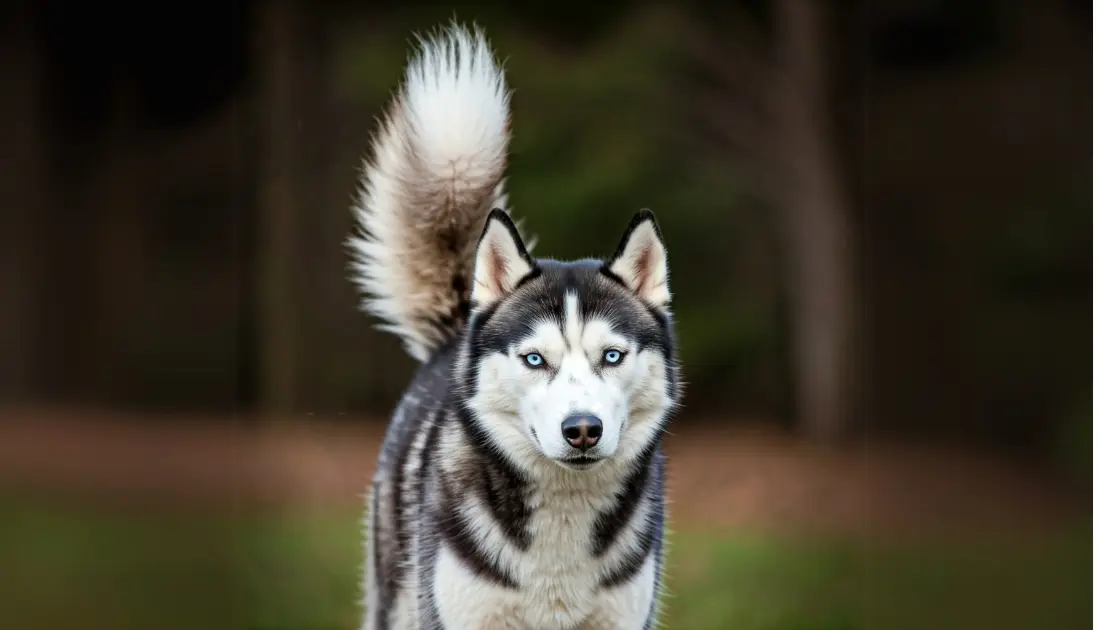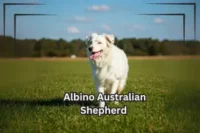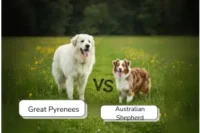Why Do Dog Wagging Tail? Uncover Joy and Stress Signals
Published: 28 Dec 2024
If you’ve ever watched your dog wag its tail, you might have wondered, “What is my dog trying to say?” While dog wagging tail is one of the most common behaviors we see in dogs, it’s often misunderstood. While it may seem simple, tail wagging can express various emotions and messages.In this blog post, we’ll explain why dogs wag their tails, how to interpret it, and what it says about your dog’s feelings.
Table of Contents
The Basics of Tail Wagging
Dogs don’t just wag their tails for no reason. Tail wagging is an essential part of canine communication. It’s a way for dogs to express themselves without using words. Just like humans use body language and facial expressions, dogs use their tails to show their emotions.
The tail’s speed, position, and movement can tell you a lot about how your dog feels. It’s essential to pay attention to the context of the wag—where your dog is, who they’re interacting with, and what else is happening around them.
Common Reasons Dogs Wag Their Tails
1. Excitement or Happiness: Dog Wagging Tail When They See You
The most common reason for a dog wagging its tail is happiness. You’ve probably seen your dog wagging their tail excitedly when you come home after a long day. This rapid tail wags, often accompanied by a happy wiggle, shows your dog is thrilled to see you. Dog wagging tail when they see you is a sure sign of excitement and affection. Their whole body might even wiggle in joy!
Example: Imagine walking through the door after work, and your dog runs over to greet you, tail wagging quickly. This is a classic sign of excitement and love.

2. Friendly Social Behavior: Dog Wagging Tail High
Dogs often wag their tails when they meet new people or other dogs. It’s a friendly way of saying, “Hello! I’m not a threat.” When your dog is feeling friendly, it might wag its tail high, indicating confidence and a welcoming attitude. A high-wagging tail suggests your dog is comfortable and ready to engage.
Example: When you take your dog to the dog park, it may wag its tail high when it meets another dog, signaling that it’s ready to play.
3. Curiosity: Dog Wagging Tail Weirdly
Dogs may also wag their tails when curious or trying to figure out something. If your dog’s wagging looks weird—perhaps in a slower, side-to-side motion—this may indicate they’re trying to understand their environment or something new, like a strange sound or unfamiliar object.
Example: If your dog hears a doorbell ring for the first time or spots a new object in the yard, you may see it wag its tail weirdly or unusually, showing that it is investigating the object.
4. Nervousness or Anxiety: Dog Wagging Tail When in Trouble
Not all tail-wagging means happiness. Sometimes, dogs wag their tails when they feel nervous or in trouble. If your dog’s tail is wagging slowly and their body is tense, it’s a sign that they might feel uncertain or anxious. A dog’s wagging tail when in trouble can indicate that your dog feels stressed or worried but doesn’t want to act aggressively.
Example: If your dog is about to go to the vet or is caught doing something it knows it shouldn’t be, its tail might wag in uneasy, slow motion, showing it’s nervous but doesn’t want to be confrontational.
5. Feeling Unwell: Dog Wagging Tail When Sick
Dogs may also wag their tails when sick, though the motion may be slower or more subdued. If your dog is ill or in pain, it might still wag its tail, but it could lack the usual enthusiasm. Dog wagging its tail when sick can sometimes be a sign that it is still trying to communicate despite not feeling well.
Example: If your dog is ill or has a mild injury, it may wag its tail weakly, signaling that it still recognizes you but might not feel its best.
6. Dreaming: Dog Wagging Tail While Dreaming
Ever notice your dog’s tail moving when they’re asleep? Dog wagging tail while dreaming is not uncommon! Just like humans, dogs experience REM (Rapid Eye Movement) sleep, during which they desire. Their tails might wag as they dream about playing, running, or engaging in other activities. This type of tail wagging is often gentler, and you might also notice other signs of dreaming, like paw twitching or rapid eye movement.
Example: “Just like some dogs shake in their sleep due to dreaming, tail wagging can also be part of their REM sleep cycle. Learn more about why dogs shake in sleep and how this relates to their behavior.”
How to Interpret Your Dog’s Tail Wag
While the general rule is that a wagging tail indicates happiness or friendliness, the meaning can change depending on the context. Here are a few things to watch for when trying to understand your dog’s tail language:
- High, stiff wagging: Often a sign of dominance, aggression, or excitement.
- Low, low wagging: Usually a sign of submission, uncertainty, or sometimes fear.
- Wide, fast wagging: A very happy, friendly, excited dog who wants to engage.
- Tucked tail: A sign of fear, anxiety, or submission. When a dog is frightened, they might tuck their tail between their legs.
“A dog’s tail is a window to their heart, wagging with every emotion they can’t put into words”
Can Tail Wagging Tell Us Anything About a Dog’s Health?
While most tail wagging is a normal part of canine behavior, there are instances where unusual tail movements could indicate a health problem. For example:
- A dog’s tail held stiffly or not moving could suggest pain, injury, or discomfort.
- A lack of tail wagging in a usually happy dog might indicate depression or illness.
Certain breeds are known for living longer, and their health can affect behaviors like tail wagging. Learn about the longest-living dog breeds and how their behavior might differ from others. If you notice sudden changes in your dog’s tail behavior, it’s worth checking with your vet. For more information on recognizing signs of health issues and understanding your pet’s behavior, check out the American Veterinary Medical Association – Pet Care.
What Should You Do When Your Dog Wags Its Tail?
If your dog is wagging its tail, it’s generally a sign that they want to communicate with you. Here are a few things you can do:
- Observe their body language: Look at the rest of their body to get clues about their feelings. Are they relaxed? Is their body tense? This will help you understand what they’re trying to communicate.
- Respond to their emotions: If your dog is wagging their tail happily, take the opportunity to bond, whether it’s with play or a walk. If they’re nervous, give them some space and time to calm down.
- Be aware of potential triggers: If your dog is wagging its tail due to anxiety or fear, try to identify the source of stress and help them feel more comfortable.
Conclusion
Tail wagging is one of dog behavior’s most interesting and informative aspects. By paying attention to how your dog wags its tail, you can better understand their feelings and improve your communication. Your dogs tell much about their excitement, curiosity, or even anxiety. So next time you see that tail wagging quickly, high, or even weirdly, consider what it might mean!
FAQ
1. Why does my dog wag its tail when it’s excited?
When your dog is excited, you’ll likely see their tail wagging like crazy! It’s their way of saying, “I’m so happy to see you or to be in this fun moment!”
2. Does tail wagging always mean happiness in dogs?
Not quite! While wagging often means happiness, it can also signify stress, nervousness, or aggression. Pay attention to your dog’s body language for clues on their feelings.
3. Why does my dog wag its tail slowly?
A slow wag can mean your dog is unsure or slightly cautious. They’re saying, “I’m not sure about this, but I’m still checking it out.”
4. Can a dog wag its tail when it’s in pain?
Yes, even when dogs are not feeling well, they’ll wag their tails. It might not be as energetic, but they could still be trying to communicate, even if they’re in pain.
5. What does it mean when my dog’s tail is tucked between its legs?
A tucked tail is usually a sign that your dog is scared, anxious, or feeling submissive. It’s like them saying, “I’m worried; please don’t hurt me.”
6. Why do dogs wag their tails when they meet new people or animals?
Tail wagging is their way of saying, “Hi there! I’m friendly!” When your dog meets new faces, they wag to show they’re not a threat and want to say hello.
7. Can my dog wag its tail while dreaming?
Yes! Like us, dogs dream, and sometimes their tails move while sleeping. They’re likely dreaming about running or playing, just like they would if they were awake.
8. What does it mean if my dog wags its tail high?
When your dog wags their tail high, it shows confidence. They say, “I’m happy and ready for whatever comes next!”
9. Why does my dog wag its tail at strange or unfamiliar objects?
If your dog is wagging its tail at something new or strange, they’re probably just curious. They say, “I’m not sure what this is, but I’m gonna check it out!”
10. How do I know if my dog is wagging its tail because it’s happy or anxious?
You can tell by looking at the rest of their body. A relaxed dog with a wagging tail is a happy dog, but if their body is tense, they might be anxious or unsure, even if the tail is still wagging.

- Be Respectful
- Stay Relevant
- Stay Positive
- True Feedback
- Encourage Discussion
- Avoid Spamming
- No Fake News
- Don't Copy-Paste
- No Personal Attacks



- Be Respectful
- Stay Relevant
- Stay Positive
- True Feedback
- Encourage Discussion
- Avoid Spamming
- No Fake News
- Don't Copy-Paste
- No Personal Attacks





